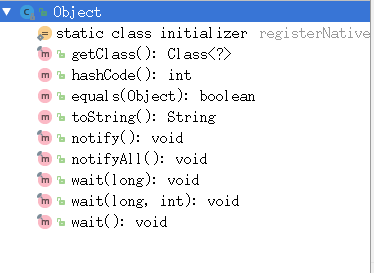Java多线程——线程间通信之wait(),notify()方法,生产者与消费者模式实现,管道流
1. wait()方法:使当前执行代码的线程进行等待。
在调用wait()之前,线程必须获得该对象的对象级别锁,即只能在同步方法或同步块中调用wait()方法(否则会抛出IllegalMonitorStateException异常)。在执行wait()方法后,当前线程释放锁。在从wait()返回之前,线程与其他线程竞争重新获得锁。
package threadCommunication;
public class WaitTest {
public static void main(String[] args) {
try {
String str = new String();
System.out.println("synchronize前");
synchronized (str) {
System.out.println("wait前");
str.wait();
System.out.println("wait后");
}
System.out.println("synchronize后");
} catch (InterruptedException e) {
e.printStackTrace();
}
}
}输出:(程序没有执行结束,线程一直处于等待状态)synchronize前 wait前
2. notify()方法:使停止的线程继续运行。
在调用notify()之前,线程必须获得该对象的对象级别锁,即只能在同步方法或同步块中调用notify()方法(否则会抛出IllegalMonitorStateException异常)。
notify()方法用来通知那些可能等待该对象的对象锁的其他线程,如果有多个线程等待,则有线程规划器随机挑选出一个呈wait()状态的线程,对其发出通知notify,并使它等待获取该对象的对象锁。
在执行notify()方法后,当前线程不会马上释放该对象锁,呈wait()状态的线程也并不能马上获取该对象锁,要等到执行notify()方法的线程将程序执行完,也就是退出synchronized代码后,当前线程才会释放锁,而呈wait()状态所在的线程才可以获取该对象锁。
package threadCommunication;
/**
* 初试notify()方法
*/
public class NotifyTest {
public static void main(String[] args) throws InterruptedException {
Object lock = new Object();
MyThreadA a = new MyThreadA(lock);
a.setName("A");
a.start();
Thread.sleep(2000);
MyThreadB b = new MyThreadB(lock);
b.setName("B");
b.start();
}
}
// 线程A
class MyThreadA extends Thread {
private Object lock;
public MyThreadA(Object lock) {
this.lock = lock;
}
@Override
public void run() {
try {
synchronized (lock) {
System.out.println("线程" + Thread.currentThread().getName() + "开始\t" + System.currentTimeMillis());
lock.wait();
System.out.println("线程" + Thread.currentThread().getName() + "结束\t" + System.currentTimeMillis());
}
} catch (InterruptedException e) {
e.printStackTrace();
}
}
}
//线程B
class MyThreadB extends Thread {
private Object lock;
public MyThreadB(Object lock) {
this.lock = lock;
}
@Override
public void run() {
synchronized (lock) {
System.out.println("线程" + Thread.currentThread().getName() + "开始\t" + System.currentTimeMillis());
lock.notify();
System.out.println("线程" + Thread.currentThread().getName() + "结束\t" + System.currentTimeMillis());
}
}
} 输出:线程:A开始 1527514984721 线程:B开始 1527514986723 线程:B结束 1527514986724 线程:A结束 1527514986724 Process finished with exit code 0
3. notifyall()方法:可以使所有正在等待队列中等待同一共享资源的“全部”线程从等待状态退出,进入可运行状态。此时,优秀级最高的那个线程最先执行,但也有可能是随机执行,这取决于JVM虚拟机的实现。
一个notify()方法可以唤醒一个线程,当等待同一锁对象的线程较少时,也可以多次(n次)调用notify()唤醒多个(n个)线程。但为了确保能够唤醒所有的线程,可以使用notify()方法。
4. sleep()方法:线程进入休眠(阻塞)状态,自动放弃当前CPU资源;但是不释放锁。
5. 小总结:
(1)执行完同步代码块就会释放对象的锁。
(2)在执行同步代码块的过程中,遇到异常而导致线程终止,锁也会被释放。
(3)在执行同步代码块的过程中,执行了锁所属对象的wait()方法,这个线程会释放对象锁,而此线程对象会进入线程等待池中,等待被唤醒。
(4)当线程呈wait()状态时,调用线程对象的interrupt()方法会出现InterruptExceptin异常。
6. wait(long timeout)方法:等待某一时间内是否有其他线程对锁进行唤醒,如果超过了这个时间则自动唤醒。也可以在timeout时间内由其他线程唤醒。
7. 要防止notify通知过早;通知过早会导致wait()进入无限等待,无法唤醒。
8. 所有的类都继承了Object 类。Object类的9个方法:

9. 生产者与消费者模式实现
等待/通知(wait/notify)模式最经典的案例就是“生产者与消费者”模式。
(1)一生产与一消费:操作值
如果操作值value为null时,customer线程进入wait;product线程执行,给value赋值,执行结束之后,唤醒customer线程并释放对象锁。
如果操作值value不为null时,product线程进入wait;customer线程执行,获取value后将其置为null,执行结束之后,唤醒product线程并释放对象锁。
package threadCommunication;
/**
* 经典wait/notify模式:生产者与消费者模式
*/
public class ProductAndCustomer {
public static void main(String[] args) throws InterruptedException {
String lock = new String("");
Product pro = new Product(lock);
Customer cus = new Customer(lock);
ThreadP p = new ThreadP(pro);
ThreadC c = new ThreadC(cus);
p.start();
c.start();
}
}
/**
* 生产者
*/
class Product {
private String lock;
public Product(String lock) {
this.lock = lock;
}
public void setValue() {
try {
synchronized (lock) {
if (!ValueObject.value.equals("")) {
lock.wait();// value不为null时,进入等待状态
}
// value为null时,进入生产模式
String value = System.currentTimeMillis() + "_" + System.nanoTime();
System.out.println("set的值是:" + value);
ValueObject.value = value;
lock.notify();
}
} catch (InterruptedException e) {
e.printStackTrace();
}
}
}
/**
* 消费者
*/
class Customer {
private String lock;
public Customer(String lock) {
this.lock = lock;
}
public void getValue() {
try {
synchronized (lock) {
if (ValueObject.value.equals("")) {
lock.wait();
}
System.out.println("get的值是:" + ValueObject.value);
ValueObject.value = "";//get之后要将value置空,以备下次生产
lock.notify();
}
} catch (InterruptedException e) {
e.printStackTrace();
}
}
}
/**
* 生产者线程
*/
class ThreadP extends Thread {
private Product pro;// 通过构造方法初始化
public ThreadP(Product pro) {
this.pro = pro;
}
@Override
public void run() {
super.run();
while (true) {
pro.setValue();
}
}
}
/**
* 消费者线程
*/
class ThreadC extends Thread {
private Customer cus;
public ThreadC(Customer cus) {
this.cus = cus;
}
@Override
public void run() {
super.run();
while (true) {
cus.getValue();
}
}
}
/**
* 存储值的工具类
*/
class ValueObject {
public static String value = "";
}(2)多生产多消费:操作值-假死 因为多生产多消费,会存在“生产者”唤醒“生产者”,“消费者”唤醒“消费者”这种情况,此情况会导致所有的生产者和消费者都呈waiting状态,线程最后也就呈“假死”状态,不能继续运行下去。
解决方法:可以使用notifyAl()方法代替notify()方法,一次性唤醒所有的线程。
(3)一生产与一消费:操作栈
本示例是使生产者向堆栈List对象中放入数据,使消费者从List对象中取出数据。List最大容量为1 。
package threadCommunication;
import java.util.ArrayList;
import java.util.List;
import java.util.Stack;
/**
* (3)一生产与一消费:操作栈
* (4)一生产与多消费:操作栈,解决wait条件改变与假死
*/
public class ProductAndCustomer2 {
private List<String> list = new ArrayList<>();
synchronized public void push() {
// if (list.size() == 1) {
while (list.size() == 1) {
System.out.println("push的操作:" + Thread.currentThread().getName() + "线程呈wait状态");
try {
this.wait();
} catch (InterruptedException e) {
e.printStackTrace();
}
}
list.add("anything=" + Math.random());
// this.notify();
this.notifyAll();
System.out.println("push=" + list.size());
}
synchronized public String pop() {
// if (list.size() == 1) {
while (list.size() == 0) {
System.out.println("pop的操作:" + Thread.currentThread().getName() + "线程呈wait状态");
try {
this.wait();
} catch (InterruptedException e) {
e.printStackTrace();
}
}
String value = list.get(0);
list.remove(0);
// this.notify();
this.notifyAll();
System.out.println("pop=" + list.size());
return value;
}
public static void main(String[] args) {
ProductAndCustomer2 productAndCustomer2 = new ProductAndCustomer2();
P p = new P(productAndCustomer2);
P p2 = new P(productAndCustomer2);
P p3 = new P(productAndCustomer2);
P p4 = new P(productAndCustomer2);
P p5 = new P(productAndCustomer2);
C c = new C(productAndCustomer2);
C c2 = new C(productAndCustomer2);
C c3 = new C(productAndCustomer2);
C c4 = new C(productAndCustomer2);
C c5 = new C(productAndCustomer2);
P_Thread p_thread = new P_Thread(p);
P_Thread p2_thread = new P_Thread(p);
P_Thread p3_thread = new P_Thread(p);
P_Thread p4_thread = new P_Thread(p);
P_Thread p5_thread = new P_Thread(p);
C_Thread c_thread = new C_Thread(c);
C_Thread c2_thread = new C_Thread(c);
C_Thread c3_thread = new C_Thread(c);
C_Thread c4_thread = new C_Thread(c);
C_Thread c5_thread = new C_Thread(c);
p_thread.start();
/* p2_thread.start();
p3_thread.start();
p4_thread.start();
p5_thread.start();*/
c_thread.start();
c2_thread.start();
c3_thread.start();
c4_thread.start();
c5_thread.start();
}
}
// 生产者
class P {
private ProductAndCustomer2 pc;
P(ProductAndCustomer2 pc) {
this.pc = pc;
}
public void pushService() {
pc.push();
}
}
// 生产者线程
class P_Thread extends Thread {
private P p;
P_Thread(P p) {
this.p = p;
}
@Override
public void run() {
super.run();
while (true) {
p.pushService();
}
}
}
// 消费者
class C {
private ProductAndCustomer2 pc;
C(ProductAndCustomer2 pc) {
this.pc = pc;
}
public void popService() {
System.out.println("pop--->" + pc.pop());
}
}
// 消费者线程
class C_Thread extends Thread {
private C c;
C_Thread(C c) {
this.c = c;
}
@Override
public void run() {
super.run();
while (true) {
c.popService();
}
}
}(4)一生产与多消费:操作栈,解决wait条件改变 与 假死问题
因为if条件发生改变时并没有得到及时的响应,所以多个呈wait状态的线程被唤醒,继而执行list.remove(0)代码而出现异常。 解决条件改变问题的方法为:将if (list.size() == 1) 改成 while(list.size() == 1)语句。
解决假死问题:将两处this.notify(); 改写成 this.notifyAll();
(5)多生产与一消费:操作栈
(6)多生产与多消费:操作栈
10. 通过管道进行线程间通信
管道流(pipeStream)是一种特殊的流,用于在不同线程间直接传送数据。一个线程发送(write)数据到输出管道,另一个线程从输入管道中读取(read)数据,实现不同线程之间的通信,而无需借助于类似临时文件之类的东西。
(1)通过管道进行线程间通信:字节流(byte)
PipedInputStream和PipedOutputStream(两个线程通过管道流进行字节数据的传输)

(2)通过管道进行线程间通信:字符流(char)
PipedReader和PipedWriter(两个线程通过管道流进行字节数据的传输)
- Java多线程通信-利用传统的线程通信wait(),notify()方法实现“生产者消费者模式”
- Java多线程——使用wait/notify实现生产者/消费者模式
- 【Java】线程wait() notify()通信 实现生产者 消费者问题
- 【线程同步】java实现生产者消费者问题与线程中的wait与notify总结
- Java基础(高级)——多线程的理解和Synchronized实例,以及线程间通信,wait,notify等方法
- Java 多线程 线程间的通信——wait及notify方法
- Java 多线程之线程间的通信——wait及notify方法
- Java Note: 多线程的同步(互斥锁)的方法对比,信号量锁,读写锁的实现,生产者-消费者模式的实现
- 基于线程实现的生产者消费者模型(Object.wait(),Object.notify()方法)
- Java 多线程(七) 线程间的通信——wait及notify方法
- Java Note: 多线程的同步(互斥锁)的方法对比,信号量锁,读写锁的实现,生产者-消费者模式的实现
- Java Note: 多线程的同步(互斥锁)的方法对比,信号量锁,读写锁的实现,生产者-消费者模式的实现
- Java Note: 多线程的同步(互斥锁)的方法对比,信号量锁,读写锁的实现,生产者-消费者模式的实现
- 线程通信之生产者消费者间wait()、notify实现
- Java 多线程(七) 线程间的通信——wait及notify方法
- Java 多线程之线程间的通信——wait及notify方法
- 使用Object类中的wait()和notify()方法实现生产者和消费者模式
- 基于线程实现的生产者消费者模型(Object.wait(),Object.notify()方法)
- java线程的wait方法和notify方法的运用(包含生产者消费者代码【已练习】)
- Java 多线程(七) 线程间的通信——wait及notify方法
